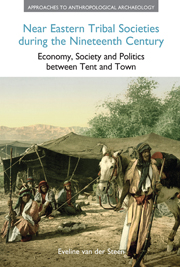 Near Eastern Tribal Societies during the Nineteenth Century
Near Eastern Tribal Societies during the Nineteenth Century Je dis, monsieur, que, les yeux fixés sur l'organisation sociale des nations, vous ne voyez que les ressorts de la machine, et non l'ouvrier sublime qui la fait agir.
(Alexandre Dumas Père, Le Comte de Monte Cristo, 1846)Introduction
Tribes, chiefdoms and early states have been defined using specific traits by Elman Service and others (see Chapter 1). Most of these traits belong to two “categories”. The first is the way in which leadership is organized and how it relates to the social group. The second is the social organization of the population: whether it is class or kinship based, and the various forms of segmentation and fusion that define sections within the group.
Three case studies are presented here, three different polities originating in the nineteenth-century tribal society of the Near East. These are the tribe of Akila Agha in Galilee; the town-based polity of Kerak; and the Emirate of Ibn Rashid on the Arabian Peninsula. These polities are followed from their origins to their final downfall, or in the case of Kerak, to its incorporation within the Ottoman Empire. They illustrate the various stages in the development of tribal social and political organizations. The case of Akila Agha and the Henadi is an example of how a tribe can evolve from a disorientated and amorphous fringe on the edge of society, what Rowton (1977) calls the “parasocial element”. The second case, the polity of Kerak, illustrates the development of what can perhaps be called a segmentary chiefdom, consisting of a number of partly nomadic, partly sedentary tribes, headed by a town-based clan.
To save this book to your Kindle, first ensure no-reply@cambridge.org is added to your Approved Personal Document E-mail List under your Personal Document Settings on the Manage Your Content and Devices page of your Amazon account. Then enter the ‘name’ part of your Kindle email address below. Find out more about saving to your Kindle.
Note you can select to save to either the @free.kindle.com or @kindle.com variations. ‘@free.kindle.com’ emails are free but can only be saved to your device when it is connected to wi-fi. ‘@kindle.com’ emails can be delivered even when you are not connected to wi-fi, but note that service fees apply.
Find out more about the Kindle Personal Document Service.
To save content items to your account, please confirm that you agree to abide by our usage policies. If this is the first time you use this feature, you will be asked to authorise Cambridge Core to connect with your account. Find out more about saving content to Dropbox.
To save content items to your account, please confirm that you agree to abide by our usage policies. If this is the first time you use this feature, you will be asked to authorise Cambridge Core to connect with your account. Find out more about saving content to Google Drive.